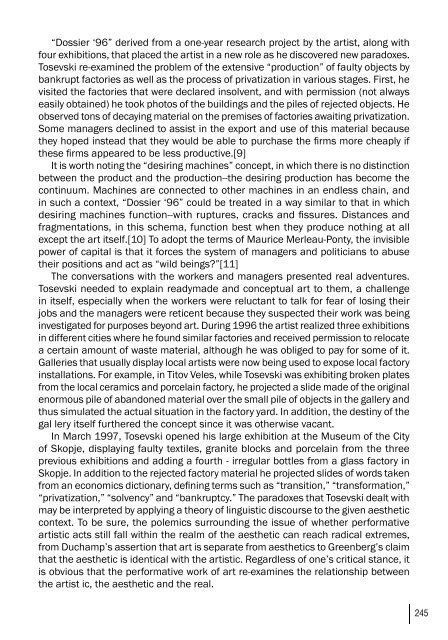art-e-conomy _ reader - marko stamenkovic
art-e-conomy _ reader - marko stamenkovic
art-e-conomy _ reader - marko stamenkovic
Create successful ePaper yourself
Turn your PDF publications into a flip-book with our unique Google optimized e-Paper software.
“Dossier ‘96” derived from a one-year research project by the <strong>art</strong>ist, along with<br />
four exhibitions, that placed the <strong>art</strong>ist in a new role as he discovered new paradoxes.<br />
Tosevski re-examined the problem of the extensive “production” of faulty objects by<br />
bankrupt factories as well as the process of privatization in various stages. First, he<br />
visited the factories that were declared insolvent, and with permission (not always<br />
easily obtained) he took photos of the buildings and the piles of rejected objects. He<br />
observed tons of decaying material on the premises of factories awaiting privatization.<br />
Some managers declined to assist in the export and use of this material because<br />
they hoped instead that they would be able to purchase the firms more cheaply if<br />
these firms appeared to be less productive.[9]<br />
It is worth noting the “desiring machines” concept, in which there is no distinction<br />
between the product and the production--the desiring production has become the<br />
continuum. Machines are connected to other machines in an endless chain, and<br />
in such a context, “Dossier ‘96” could be treated in a way similar to that in which<br />
desiring machines function--with ruptures, cracks and fissures. Distances and<br />
fragmentations, in this schema, function best when they produce nothing at all<br />
except the <strong>art</strong> itself.[10] To adopt the terms of Maurice Merleau-Ponty, the invisible<br />
power of capital is that it forces the system of managers and politicians to abuse<br />
their positions and act as “wild beings?”[11]<br />
The conversations with the workers and managers presented real adventures.<br />
Tosevski needed to explain readymade and conceptual <strong>art</strong> to them, a challenge<br />
in itself, especially when the workers were reluctant to talk for fear of losing their<br />
jobs and the managers were reticent because they suspected their work was being<br />
investigated for purposes beyond <strong>art</strong>. During 1996 the <strong>art</strong>ist realized three exhibitions<br />
in different cities where he found similar factories and received permission to relocate<br />
a certain amount of waste material, although he was obliged to pay for some of it.<br />
Galleries that usually display local <strong>art</strong>ists were now being used to expose local factory<br />
installations. For example, in Titov Veles, while Tosevski was exhibiting broken plates<br />
from the local ceramics and porcelain factory, he projected a slide made of the original<br />
enormous pile of abandoned material over the small pile of objects in the gallery and<br />
thus simulated the actual situation in the factory yard. In addition, the destiny of the<br />
gal lery itself furthered the concept since it was otherwise vacant.<br />
In March 1997, Tosevski opened his large exhibition at the Museum of the City<br />
of Skopje, displaying faulty textiles, granite blocks and porcelain from the three<br />
previous exhibitions and adding a fourth - irregular bottles from a glass factory in<br />
Skopje. In addition to the rejected factory material he projected slides of words taken<br />
from an economics dictionary, defining terms such as “transition,” “transformation,”<br />
“privatization,” “solvency” and “bankruptcy.” The paradoxes that Tosevski dealt with<br />
may be interpreted by applying a theory of linguistic discourse to the given aesthetic<br />
context. To be sure, the polemics surrounding the issue of whether performative<br />
<strong>art</strong>istic acts still fall within the realm of the aesthetic can reach radical extremes,<br />
from Duchamp’s assertion that <strong>art</strong> is separate from aesthetics to Greenberg’s claim<br />
that the aesthetic is identical with the <strong>art</strong>istic. Regardless of one’s critical stance, it<br />
is obvious that the performative work of <strong>art</strong> re-examines the relationship between<br />
the <strong>art</strong>ist ic, the aesthetic and the real.<br />
245


